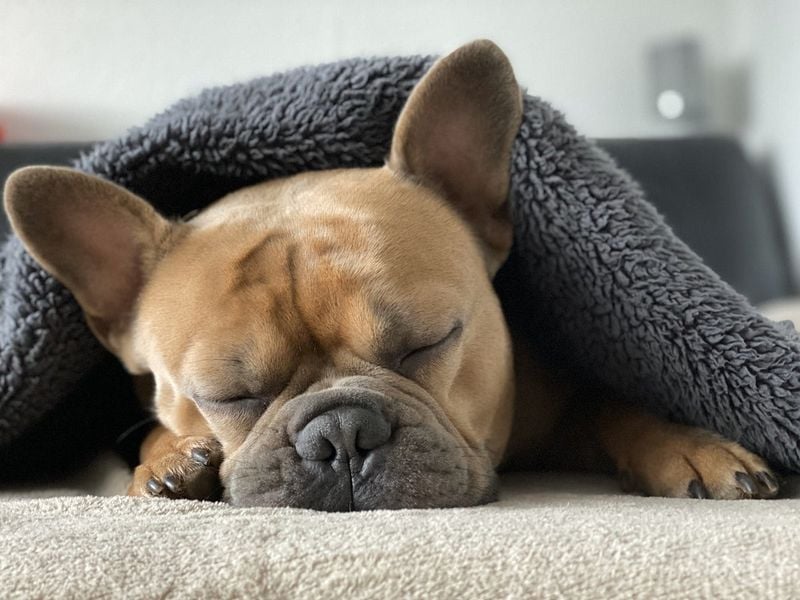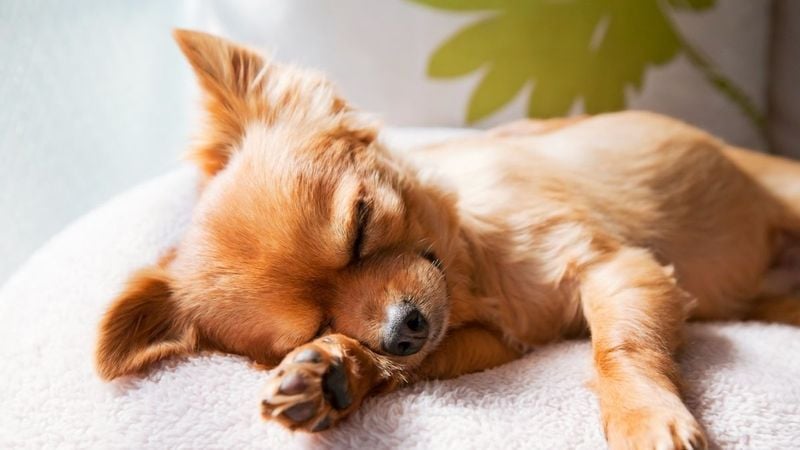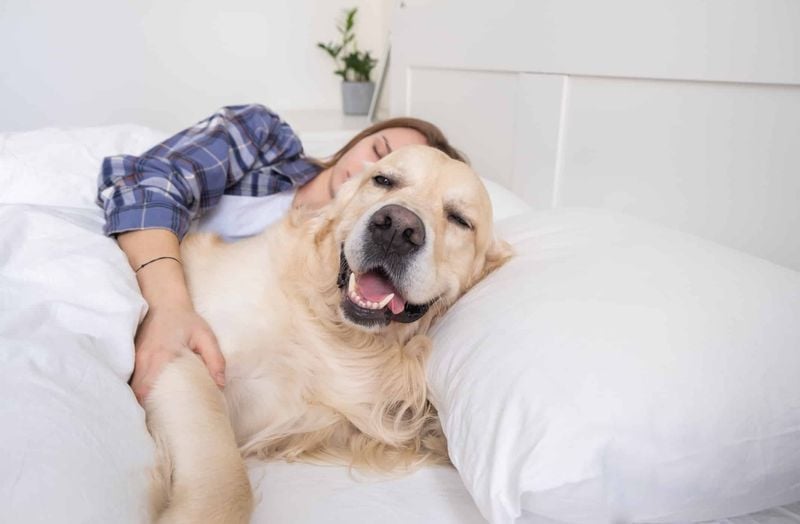10 Ways Dogs’ Sleep Cycles Differ From Humans
Ever wonder why your dog naps all day but still seems ready for bed when you are?
Their sleep habits can feel puzzling—especially when they’re snoring one minute and barking at the window the next. That’s because dogs don’t sleep like humans do, and their internal rhythms are tuned to a completely different beat.
While we rely on long, uninterrupted nighttime rest, dogs take a more flexible approach. They nap often, drift in and out of dream states quickly, and can wake up fully alert in seconds.
It’s all tied to their evolution, instincts, age, and even breed. Understanding these differences doesn’t just satisfy curiosity—it can help you provide better care.
Here’s a closer look at the fascinating ways dogs’ sleep cycles differ from ours, and why it matters for your furry friend’s health.
1. Dogs Spend More Time in Light Sleep
When your dog seems to be dozing off but still twitches an ear at every sound, it’s not your imagination—they’re likely in light sleep.
Unlike humans, who sink into long periods of deep, restorative slumber, dogs hover in lighter stages for much of their rest. This makes them more responsive to their environment, even while asleep.
It’s a survival trait. In the wild, staying lightly asleep helped dogs detect predators or changes in their surroundings. This means that while your pup may clock many hours asleep, the quality isn’t always what it seems.
Their bodies and brains remain semi-alert, ready to snap to attention if needed. For pet owners, it helps explain why even a whisper can rouse your snoozing companion, and why they always seem one step away from waking up.
2. Shorter Sleep Cycles
While humans go through 90-minute sleep cycles, dogs have much shorter ones—typically around 20 minutes.
This difference means they fall into and out of REM sleep more frequently, but the REM stages themselves are briefer. In practice, dogs experience more transitions between sleep stages than we do.
This might be why you see your dog twitch, kick, or vocalize more often while sleeping. They’re likely cycling through REM, the dream phase, where brain activity spikes.
But because each cycle is short, they rarely stay in any one stage for long. This fragmented style of rest suits their needs, allowing quick responses to noise or movement.
However, it also means dogs don’t get the long, uninterrupted deep sleep we rely on for feeling refreshed. Their rest is just enough to recharge in short bursts rather than long stretches.
3. Polyphasic vs. Monophasic Sleep
Humans usually follow a monophasic sleep pattern—we sleep once a day, ideally at night, for about 7–9 hours straight. Dogs, on the other hand, are polyphasic sleepers.
That means they sleep in several shorter segments scattered throughout the day and night. If you’ve ever noticed your dog taking five naps before dinner, that’s completely normal.
This pattern allows them to adapt to different household routines and react to changes quickly.
It also explains why dogs don’t seem bothered by being woken up—they’ll just snooze again later.
Their flexible approach to sleep evolved from a need to remain alert to threats while still getting adequate rest.
For pet owners, understanding polyphasic sleep helps in creating routines that allow dogs to rest when they need to and play when they’re ready, without expecting them to match our own sleep schedules.
4. More Total Sleep Hours
Dogs sleep far more than humans do—most adult dogs average 12 to 14 hours a day.
Puppies, seniors, and larger breeds often need even more, with some clocking up to 18–20 hours of rest within a 24-hour period. That might seem excessive by human standards, but it’s perfectly normal.
Unlike us, dogs spread this sleep throughout the day. They take short naps in between bursts of activity, conserving energy for playtime, walks, and meals.
Their need for extra rest supports their immune function, muscle recovery, and brain development, especially in growing puppies.
So if your dog seems “lazy,” they’re likely just following their biology. Ensuring they have a quiet, comfortable place to rest during the day supports their health.
Rather than trying to keep them constantly stimulated, let them enjoy their extra zzz’s—sleep is vital to their wellbeing.
5. REM Sleep Is Less Intense
Dogs do dream, but their REM (Rapid Eye Movement) sleep is shorter and less intense than that of humans.
While we may spend up to 25% of our sleep in the REM stage, dogs only spend around 10%. That means their dreams are shorter, and their emotional processing through dreams may not be as complex.
Still, REM sleep is important for your dog’s mental and physical health. During this phase, you might notice them twitching, barking softly, or paddling their legs—clues that they’re acting out dream scenarios.
Puppies experience more REM sleep than adult dogs, likely because they’re processing new experiences. Even though their REM periods are brief, they still provide cognitive benefits.
It’s another reason why frequent naps are so crucial. Waking your dog mid-dream may not harm them, but letting them finish a full cycle helps them stay mentally sharp.
6. Breed and Size Influence Sleep
Not all dogs sleep the same way—breed and size have a significant impact. Larger dogs, such as Great Danes or Saint Bernards, tend to sleep more than their smaller counterparts.
Their bigger bodies require more energy to maintain, and rest helps them recover between activity bursts. Smaller breeds like Terriers may be more alert and nap less frequently.
Working breeds such as Border Collies or German Shepherds also have different sleep needs. These dogs are mentally active and benefit from more stimulation, so they may sleep less out of sheer drive.
However, even within breeds, individual personalities play a role. Some dogs are naturally more energetic, while others love lounging.
Knowing your dog’s breed tendencies can help set realistic expectations and ensure you’re not over- or under-exercising them. It also helps explain why some pups are always snoozing while others seem wired around the clock.
7. Age-Dependent Sleep Patterns
A dog’s age plays a major role in how they sleep. Puppies need a lot of rest—sometimes up to 20 hours a day—because their growing bodies and developing brains are constantly processing new information.
They’ll often fall asleep mid-play or after meals, needing short bursts of rest throughout the day.
Adult dogs settle into a more regular sleep routine, averaging 12–14 hours daily. But as dogs age, sleep needs shift again. Senior dogs tire more easily and may return to the long napping patterns of puppyhood.
Their sleep can become lighter, and they might wake more often during the night, especially if they’re dealing with joint pain or cognitive decline. Being aware of these changes helps you adapt their environment.
Soft beds, reduced nighttime noise, and extra rest breaks during the day can help your dog stay comfortable and supported at every stage of life.
8. Instant Wakefulness
Dogs are built for alertness, even in their sleep. While a human might struggle to wake from deep slumber and take a few minutes to feel coherent, dogs can be on their feet and attentive in seconds.
This rapid shift from sleep to wakefulness is an evolutionary adaptation for survival.
In the wild, predators or threats could appear at any time, so dogs developed the ability to snap into awareness quickly.
Even domestic dogs maintain this instinct. You might notice your pup jumping up at the slightest creak or bark from outside, despite appearing fully asleep just moments before.
This trait is especially common in guard dog breeds, whose sleep is naturally lighter and more reactive.
While it can be frustrating when your dog wakes you with sudden barking at 2 a.m., it’s simply their ancient instincts doing their job—protecting their pack.
9. Environment-Driven Sleep Timing
Dogs are highly attuned to their environment and the people in it. Over time, they tend to sync their sleep patterns with their owners’ routines.
If your household is quiet at night and active during the day, your dog will adjust accordingly. They’ll nap while you’re at work and settle in when the lights go down.
This flexibility helps dogs coexist smoothly with humans, even if their natural sleep rhythm is polyphasic. Their internal clocks—called circadian rhythms—can adjust based on feeding schedules, playtime, and your general energy levels.
However, frequent disruptions like loud noises, travel, or shifting schedules can throw them off.
Maintaining consistency with meal times, bedtime, and daily activities supports healthy sleep. Creating a calm environment at night helps reinforce that it’s time to rest.
Just like us, dogs appreciate predictability—it makes them feel safe and lets their body prepare for sleep more easily.
10. They Don’t Always Sleep Through the Night
It’s completely normal for dogs to wake up multiple times during the night. While humans strive for uninterrupted sleep, dogs have evolved to rest in shorter chunks.
They may shift positions, patrol the house briefly, or even come over to check on you before settling back down.
These wake-ups usually aren’t a sign of distress—they’re just part of how dogs sleep. That said, excessive nighttime activity can signal issues like anxiety, discomfort, or needing a bathroom break.
Puppies and senior dogs are especially prone to night waking due to underdeveloped or aging bladders. Keeping a consistent bedtime routine and offering a pre-bed potty trip can help.
Some owners also find that white noise machines or calming scents like lavender ease their dog’s restlessness.
If your dog isn’t sleeping through the night, understanding this natural rhythm helps reduce frustration—and encourages more restful nights for both of you.
















